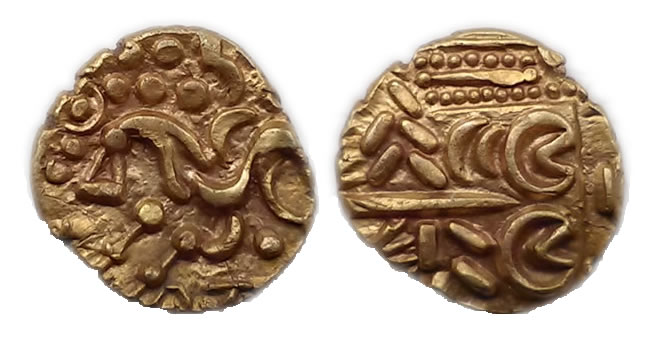Stater – North East Coast Type
Quite a number of detectorists have dug up an Ancient British gold stater but the majority have never had a sniff of one. Much depends on where you have permission to search. A good number come out of southern and eastern (up to Yorkshire) areas, which were occupied by Ancient British tribes. Hardly any have come from anywhere else. Pictured here is a really delightful gold stater (6.20 grams, 18.30mm in diameter). The finder, Brian Mansfield, described as beautiful. For those who aren’t ‘into’ Ancient British coins it will be ‘Yet another with a horse on one side’. Those who do like this series would love to have found this coin and will like it even more after reading my description.
North East Coast Type
The stater is an example of the North East Coast type, which is listed in the Standard Catalogue as number 29 but it was struck by the Corieltavi. Ancient British Coins (published by Chris Rudd) goes into more detail and lists more varieties for this type. After finding the coin Brian reported it. It was identified as number 1731 in Ancient British Coins (a North East Coast Sun type). However, Brian said he had traced similar coins but not exactly the same so he wanted to know if the ID was correct. Well, this is a North East Coast type stater but it isn’t ABC 1731.
Excessively rare
The obverse has the usual wreath motif but at the top are two distinct lines of pellets. The reverse has a disjointed horse facing left, with five large pellets above and what might be meant to represent the hand of a charioteer, a ring and dot over the horse’s head, a pellet below the horse and sloping lines under the ground line. The obverse looks peculiar and differs from the norm as it is inverted. Had it been ABC 1731 it would have been very rare but the inverted obverse make a whole load of difference. This turns this stater into a coin that is excessively rare. I traced only one specimen, which was struck from very similar but slightly different dies to this coin. It’s so rare that it isn’t in Ancient British Coins, which is the most comprehensive reference work on the period.
Superb Condition
As if that isn’t enough, it is also in superb condition. It’s an excellent strike and looks as good as it did when the hammerman took it from between the dies. Therefore, all in all, this is one of the most important Ancient British gold staters that I’ve been privileged to write about. My heartiest congratulations go to Brian Mansfield.
Valuation
Brian required a valuation purposes so I said not less than £4,000.
Coin Valuation Service
Have your coin or artefact identified or valued using my free online coin valuation service


Some further detail from Liz Cottam of Chris Rudd. .. I did check current rarity with Dr John Sills who records for the Celtic Coin Index and he tells me:
“There are seven others from the same obverse die as this one, with an inverted design. Four have a right-facing horse on the reverse and three a left-facing horse, as here; this one’s from a new reverse die and important as such. There’s a fourth left-facing specimen from a different pair of dies, 63.0009, which has a rosette as well as a pellet below the horse. The group as a whole stands at the transition between the pellet type and the rosette type at my Mint B, which may help to explain its unusual features. There’s another inverted obverse variant later in the series, which is commoner, but it’s in a different ‘crude’ style and not closely related to this one. This type of error seems to have been caused by an engraver copying a coin rather than a die, resulting in a ‘mirror image’ design.”
Hi Peter, you may be interested in the comments copied below from Liz Cottam at Chris Rudd.
Regards, Brian
Thank you for your email. Most interesting. It’s not the case that the coin is so rare that it isn’t recorded in ABC as we obviously have lots of rare and unique types in there, it is simply that the North East Coast is a huge series with many variants and when we published in 2010 we had to make a decision as to which we included.